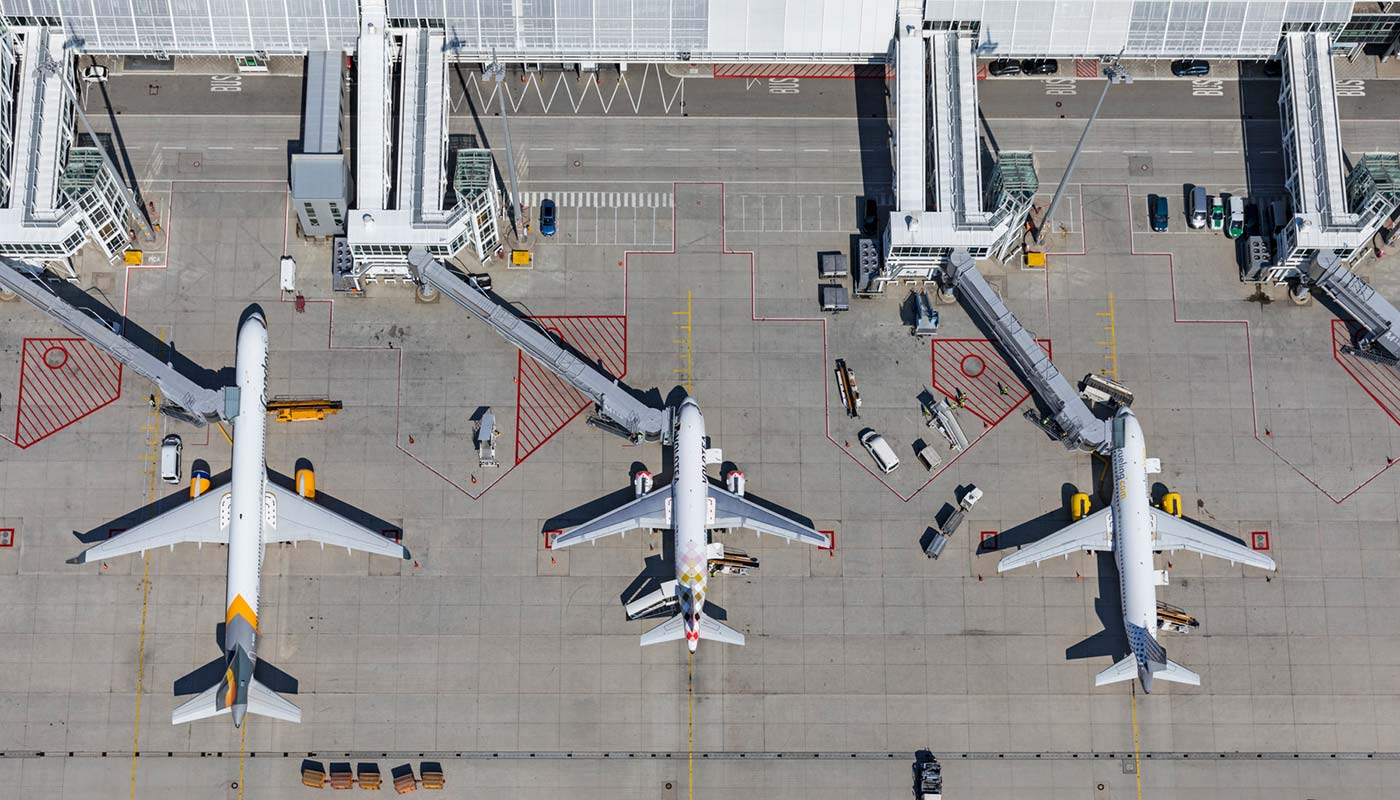
luftaufnahme vorfeld t1
The ‘Fit for 55’ policy package from the European Commission to curb gas house emissions from amongst others the airline industry has been met with mixed reactions. European stakeholders and lobby groups are strongly opposing the taxation of aviation fuel. They applaud the initiative to promote sustainable aviation fuels (SAF) but are critical that the Commission has failed to propose incentives for more SAF production. Plus, EU stakeholders fear ‘carbon leakage’.
The package was announced on July 14, as reported by Airinsight. It includes the taxation of kerosene, mandates to grow the availability of SAFs from two percent in 2025 to 63 percent in 2050, and an end to free allowances under the Emissions Trade System (ETS).
As reported, IATA condemns the taxation plan as any additional burden on the airlines will prevent them from investing in sustainable initiatives. The lack of incentives for SAF producers to increase production volumes is a lost opportunity, IATA says, as is the failure to commit strongly to the Single European Sky project to optimize air traffic management and, hence, reduce carbon emissions.
Other stakeholders have also responded to the ‘Fit for 55’-initiative. Here are some reactions:
In a joint statement, the European Regions Airlines Association (ERA), Airlines 4 Europe (A4E), ACI Europe, and the Civil Air Navigation Services Organization (CANSO) do not comment directly on the policy package. Instead, they call on the Commission to support their own initiative, known as Destination 2050. “To support the ‘Fit for 55’ initiative and ensure climate targets can be reached, Europe’s leading airlines, airports, air navigation service providers and manufacturers have proposed the development of an EU Pact for Sustainable Aviation – a joint roadmap for industry and policymakers to align their actions towards realizing the 2030 and 2050 climate goals. The Pact – led by the European Commission – would set out a shared vision, common aspirational targets, and high-level principles for joint aviation and policymaker action.”
Destination 2050 initiative was launched earlier this year. The organizations say it shows how a combination of measures across four pillars can be used to achieve net-zero CO2 emissions from aviation by 2050 by improvements in aircraft and engine technologies, by the ramp-up in production and uptake of SAFs, by the implementation of smart economic measures, and by improvements in air traffic management (ATM) and aircraft operations.
Europeans for Fair Competition (E4FC), a coalition of EU airlines and unions, support the initiative to reduce carbon emissions. However, it sees “the need to introduce smart measures to avoid competitive distortion and carbon leakage.” E4FC stresses that aviation “is a global industry and legislation cannot address it in isolation from the rest of the world.”
The coalition also fears that the substantial investments needed to implement the initiatives will add costs to European airlines and distort the global competitiveness of European network airlines and their employees. “As parts of the proposals have the potential to trigger “carbon leakage” (counteracting the environmental efforts of the EU), E4FC is calling for smart measures to avoid such effects, for example by including aviation in a Carbon Border Adjustment Mechanism (CBAM). This is not the case in today’s proposals.”
The argument of ‘carbon leakage’ is also mentioned by the Bundesverband der Deutschen Luftverkehrswirtschaft (BDL), the association of the aviation industry in Germany. It supports far-reaching initiatives for the ecological modernization of the industry. Chairman Peter Bender says in a statement: “The opportunity to make the instruments competition-neutral was missed. The proposed measures do not provide sufficient carbon leakage protection and therefore threaten to come to nothing in terms of climate policy. They harm European airlines and airports in competition and significantly lead to a shift of emissions to competitors from third countries.”
Some individual airlines have also responded, like easyjet. It calls the proposal a ‘landmark moment for Europe’ and fully supports the initiative to achieve net-zero by 2050 or sooner. But it criticizes the taxation plan on fuel for intra-EU flights only as it doesn’t address long-haul flights, nor does it replace existing “ineffective passenger taxes.” It isn’t clear if the UK, a non-EU member since Brexit, will follow the EU with its own taxation plan.
easyjet CEO Johan Lundgren says: “There can be no double taxation, any fuel tax must include the replacement of all the ineffective passenger taxes in Europe with a combination of a fuel tax for intra-EU flights and a flight tax for long-haul flights that reflects their emissions. This way all airlines and passengers are incentivized to fly more efficiently.”
Lundgren continues: “We commend the European Commission’s move towards a full-scope and non-discriminatory Sustainable Aviation Fuel mandate, which will ensure equal treatment and fair competition. We now call for the same principle to be applied on other environmental policies such as the fuel tax and the Emissions Trading System.”
KLM supports the initiative to achieve climate neutrality by 2050 and is delighted that ‘Fit for 55’ corresponds well with the Destination 2050 plan mentioned earlier. The Dutch airline also welcomes the plan to upscale the production and use of SAFs but stresses the importance of implementing the Single European Sky as more efficient air traffic management can reduce emissions by ten percent.
KLM says: “Introducing general levies, such as a European kerosene tax, will not achieve this, because they do not directly lead to a reduction in CO2 emissions and moreover the revenues raised are not invested in boosting sustainability in the industry. Kerosene tax may well have the opposite effect, leading to aircraft flying longer routes to circumvent the tax and thereby increasing emissions.”
Views: 1





